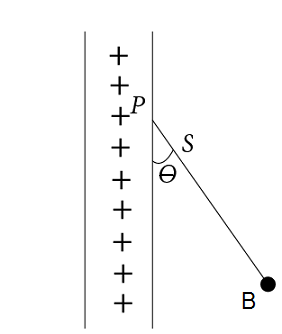Test: Application of Gauss's Law (NCERT) - NEET MCQ
10 Questions MCQ Test NCERTs at Fingertips: Textbooks, Tests & Solutions - Test: Application of Gauss's Law (NCERT)
Two parallel infinite line charges + λ and -λ are placed with a separation distance R in free space. Then etelectric field exactly mid - way between the two line charges is
An electric dipole consists of charges ±2.0 x 10-8C separated by a distance of 2.0 x 10-3 m. It is placed near a long line charge of linear charge density 4.0 x 10-4C m-1 as shown in the figure, such that the negative charge is at a distance of 2.0 cm from the line charge. The force acting on the dipole will be
| 1 Crore+ students have signed up on EduRev. Have you? Download the App |
Two infinite plane parallel sheets, separated by a distance d have equal and opposite uniform charge desities σ. Electric field at a point between the sheets is
Two large, thin metal places are parallel and close to each other. On their faces, the plates have surface charge densities of opposite signs and of magnitude 16 x 10-22 C m-2. The electric field between the plates is
Two large thin metal plates are parallel and close to each other. On their inner faces, the plates have surface charge densities of opposite signs and magnitude 27 x 10-22C m-2. The electric field  in region II in between the plates is
in region II in between the plates is

A charged ball B hangs from a silk thread S, which makes an angle θ with a large charged conducting sheet P as shown in the figure. The surface charge density of the sheet is proportional to

Consider a thin spherical shell of radius R consisting of uniform surface charge density σ. The electric field at a point of distance x from its centre and outside the shell is
A non conducting sphere of radius a has a net charge +q uniformly distributed throughout its volume. A spherical conducting shell having inner and outer radii b and c and net charge −q is concentric with the sphere (see the figure).

Read the following statements
(i) The electric field at a distance r from the center of the sphere for r<a is 
(ii) The electric field at distance r for A<r<b is 0
(iii) The electric field at distance r for b<r<c is 0
(iv) The charge on the inner surface of the spherical shell is −q
(v) The charge on the outer surface of the spherical shell is +q
Which of the above statements are true?
There is a solid sphere of radius R having uniformly distributed charge throughout it. What is the relation between electric field E and distance r from the centre (r < R)?
An early model for an atom considered it to have a positively charged point nucleus of charge Ze, surrounded by a uniform density of negative charge upto a radius R. The atom as a whole is neutral. The electric field at a distance r from the nucleus is (r < R).

|
257 docs|234 tests
|
|
257 docs|234 tests
|


 away from +λ
away from +λ




 in the region II, in between the plates =
in the region II, in between the plates = 3.05 x 10-10N C-1
3.05 x 10-10N C-1





 Using (i)
Using (i)










